How Russia Beat
America to the
Hypersonic Missile
A near-unstoppable weapon has entered the war in Ukraine,
and the U.S. has no way to match it—yet.
On March 18, nearly one month into the invasion of Ukraine, a Russian Air Force MiG-31B took to the skies bearing a 26-foot white rocket against its belly, bound for an ammunition depot in western Ukraine. This type of rocket, dubbed the Kh-47M2 Kinzhal—“dagger” in Russian—had only been fired twice in history, both times for tests; this was its first appearance in active conflict. According to the Russian Defense Ministry, the Kinzhal destroyed the depot, pushing the war in Ukraine into a troubling new phase of uncertainty and escalation.
With a reported range of more than 1,200 miles and a claimed top speed of Mach 10, the Kinzhal is an air-launched weapon based on Russia’s 9K720 Iskander short-range ballistic missile. Like all ballistic missiles, the Kinzhal achieves hypersonic velocities using a rocket engine and an arcing ballistic flight path. But Russia claims the Kinzhal can perform evasive maneuvers at every leg of its journey. It’s a weapon described by President Joe Biden as “almost impossible to stop.”
“Hypersonic” describes vehicles that can travel faster than Mach 5, or 3,836 miles per hour, a new frontier in the world of military technology. Hypersonic weapons so far take two main forms: boost-glide vehicles and hypersonic cruise missiles. The former type, a successor to the ballistic missile, takes slightly flatter flight paths and adjusts course during gliding descents. The latter is powered by a new propulsion system called a scramjet. Boost-glide vehicles offer maneuverability and faster top speeds. They can reach Mach 20, while hypersonic cruise missiles max out around Mach 5.
The Kh-47M2 Kinzhal is neither a boost-glide vehicle nor a cruise missile, however. It isn’t a gliding body, and it’s powered by an old-fashioned rocket rather than a scramjet. The Kinzhal is an air-launched ballistic missile that Russia claims can adjust course midflight. It’s not the pinnacle of modern missile technology, but it’s the first of its kind to appear in combat, and it has forced Russia, the United States, and China to assess their respective hypersonic capabilities. For the U.S., this is not a flattering point of comparison.
The United States has conducted 17 different hypersonic-missile tests since 2010, and it has seen 10 failures. The most recent U.S. test, in March 2022, was a success, but America is at least a year away from fielding a hypersonic weapon in combat. Russia and China, meanwhile, both claim to have hypersonic weapons in service now.
In addition to the first Kinzhal launch on March 18, Russia fired a second Kinzhal the following day, at a fuel depot near the Black Sea port of Mykolaiv. Based on the Kinzhal’s range, it’s reasonable to guess that the missiles were fired from inside Russian airspace, eliminating the chance that Ukrainian air defenses could stop the attack by shooting the fighter down before it launched the missile. And once the missile is in flight, there’s little to nothing that modern military forces can do to defend against it. For the U.S. Navy, this tech gap represents “a warfighting asymmetry that must be addressed.”
The shortest technological route to a hypersonic missile is to develop a boost-glide vehicle. These weapons usually enter the sky using conventional rocket boosters—similar to a nuclear ICBM—before they separate from the rocket and begin an unpowered descent. This design builds upon decades-old ballistic missile technology with an added pinch of cutting-edge aeronautics, and that means powers such as Russia and China can weld together hypersonics and technically call them “operational,” even if they’re limited in use.
Boost-glide vehicles achieve incredible speeds—some faster than Mach 20 (about 15,345 miles per hour)—but it’s their elusiveness, not their velocity, that earns them their indefensible reputation. Modern missile defense systems use elaborate math to analyze a missile’s trajectory and launch interceptors to cross its path at a predicted point. But hypersonic boost-glide weapons shift trajectory to render these predictions, and the systems that produce them, useless.
For the military powers in the hypersonics arms race, how these weapons change course is a secret. Movable control surfaces—like the flaps you’d find on an aircraft—don’t work well at high altitudes, where the air is too thin for a wing’s shape to create lift. At these heights, many vehicles use chemical thrusters called Reaction Control Systems (RCS) to adjust roll, pitch, and yaw. These burn chemicals like hydrogen peroxide or hypergolic fuel to expel small bursts of energy in specific directions and adjust the vehicle’s orientation. RCS systems work in the thin atmosphere of high altitudes, but they aren’t as effective in the denser air closer to a target.
These obstacles tell Christopher Combs, Ph.D., an assistant professor of aerodynamics at the University of Texas at San Antonio and a former NASA research fellow, that advanced hypersonic boost-glide weapons probably use a combination of the two. That was the case with the Space Shuttle, which often exceeded Mach 25 during reentry. But even with this combination, the challenges of steering a vehicle at hypersonic speeds are significant. Control surfaces like flaps rely on consistent forces from the air they pass through, but the intense friction and pressure of hypersonic travel can change the physical and transport properties of air itself, making those forces unpredictable. Conventional physics flies out the window.
Variables from inside the vehicles themselves are another factor—at hypersonic speeds, RCS systems produce unintended results. “You fire a jet that should make you move one way, and you go the opposite direction,” Combs says. “It gets weird. I’m highly skeptical of any claims of meaningful maneuverability [in hypersonic boost-glide vehicles]. You definitely wouldn’t expect one of these vehicles to be doing Top Gunstuff.”
Despite hypersonics’ speed, boost glide vehicles don’t actually reach their targets faster than traditional ballistic missiles. Hypersonics’ flatter flight path and adjustments in course slow their approach. Nonetheless, upon impact, they generate massive amounts of power even with nonnuclear payloads. An object’s kinetic energy increases exponentially with its speed, meaning a hypersonic missile’s destructive potential becomes devastating in a hurry. “Speaking generally, a Mach 6 system doesn’t have six times the kinetic energy of a similar Mach 1 system, but rather 36 times,” says Joseph Jewell, Ph.D., an assistant professor at Purdue University’s School of Aeronautics and Astronautics who spent five years in the Hypersonic Sciences Branch of the U.S. Air Force Research Laboratory.
In a 2018 speech, Russian President Vladimir Putin unveiled two weapons he claimed would render American missile defenses “useless.” One was the Avangard boost-glide vehicle; the other was the Kinzhal. Both weapons, according to the Kremlin, have nuclear capabilities. Russia currently has 10 aircraft that can carry the nuclear-armed Kinzhals—a fleet of modified MiG-31s similar to the MiG-31B used in the March launch in Ukraine.
The Kinzhal might be dated, but the Avangard is a true hypersonic weapon in the modern sense, with greater range and power than the Kinzhal. In service since 2019 and expected to be deployed by Russia’s forthcoming RS-28 Sarmat ICBM when it comes online later this year, the Avangard is said to have a range of 3,700 miles, a top speed of Mach 20, and payload capabilities amounting to a two-megaton nuclear weapon. That’s 125 times more powerful than the atomic bomb dropped over Hiroshima in 1945.
China’s hypersonic boost-glide vehicle, the DF-ZF, has a shorter range than the Avangard (about 1,553 miles). American intelligence reports lack specifics about the DF-ZF’s destructive yield, but note that it is nuclear capable. Reports specify that the vehicle is intended to serve as an anti-ship weapon capable of sinking American aircraft carriers. Hitting a carrier from over a thousand miles away, however, is a significant challenge.
In a world precariously balanced on such philosophies as mutually assured destruction (MAD), there’s a driving need for rival nations to match military capabilities to prevent war. But the high cost of the war on terrorism forced the United States to shift resources away from developing new weapons technology, placing hypersonics and other near-peer deterrents on the defensive back burner. Now the U.S. is still at least a year away from fielding its first hypersonic weapon, which would place it three to six years behind Russia and China. In other words, the Pentagon is only driving to the stadium while its opponents are already on the field. And the U.S.’s route might not be efficient: The Pentagon is committed to developing only conventionally armed hypersonics, which are more difficult to field than nuclear ones. “When you need to hit a small target with high precision, that makes [development] enormously more complex,” says Combs.
Nuclear weapons can be less accurate than conventional ballistics because their massive blast radius will envelop the target even without a direct hit. According to a report from the Congressional Research Service, conventional weapons need to be as much as 100 times more accurate to be effective.
The United States isn’t shying away from the challenge of conventional hypersonic payloads, but the engineering obstacles have so far proven too steep for the Pentagon. Both of the U.S.’s two disclosed boost-glide weapons—the Navy and Air Force’s Conventional Prompt Strike weapon and Lockheed Martin’s AGM-183 Air-Launched Rapid Response Weapon (ARRW)—have failed recent tests. Meanwhile, the U.S. is supplementing its boost-glide development with a hypersonic cruise-missile program, powered by a new method of propulsion that could theoretically leapfrog its capabilities past Russia and China.
Drag poses the biggest challenge to a hypersonic missile. When an aircraft approaches the speed of sound, air starts to compress against the aircraft body, making the sound barrier almost literal. The hypersonic barrier isn’t as sharply defined—air doesn’t behave much differently between Mach 4 and Mach 5—but the challenges of high-speed flight compound the faster you go. Air resistance increases in proportion to an aircraft’s velocity squared, so the faster a missile flies, the more drag it experiences at an exponential rate. Drag not only slows vehicles down but also converts kinetic energy into thermal energy, superheating the vehicle and the air surrounding it. At hypersonic speeds, the leading edge of a vehicle can reach sustained temperatures in the thousands of degrees Fahrenheit. In order to survive such extremes, missile armor requires special aerospace-grade titanium or aluminum alloys.
A supersonic combustion ramjet—“scramjet”—harnesses the pressure of incoming airflow to compress the air inside its combustion chamber before mixing it with fuel and igniting it. A traditional ramjet uses an inlet cone to slow the inflowing air to subsonic speeds, but a scramjet allows the air to travel at supersonic speeds before combustion. While NASA predicts a ramjet-style engine would top out at Mach 6, scramjets could sustain speeds as high as Mach 15. Easier said than done.
“A scramjet-powered hypersonic cruise missile, while flying at more moderate hypersonic Mach numbers, has to keep the engine lit and extract energy from its fuel while the flow inside the scramjet itself is supersonic. It’s been compared to keeping a lighter lit in the middle of a hurricane,” says Jewell.
So far, the U.S. has kept that metaphorical lighter lit during its hypersonic scramjet tests, but the supporting systems have been disappointing. Over the past 12 years, the U.S. has conducted eight tests of scramjet-powered weapons, with five successes. Of the three failures, two were due to problems unrelated to the scramjets.
“Overall we are making good, steady progress, and we anticipate numerous important test activities in 2022,” says Eric Scherff, pice president of hypersonic strike programs at Lockheed Martin Space. “Sure, there’s still work to do to field these systems, but we have confidence in what we’re doing and that we will be successful.”
Currently the U.S. has four disclosed scramjet cruise missile programs in development, including the Air Force’s air-to-ground Hypersonic Attack Cruise Missile (HACM) and the Navy’s ship-hunting Offensive Anti-Surface Warfare (OASuW) Increment 2, meant for America’s carrier-based fighters. Russia claimed its scramjet program, the 3M22 Tsirkon, was almost done with testing in December 2021, but current sanctions in response to its invasion of Ukraine could slow that progress. As of now, when it comes to scramjets specifically, the Pentagon is the front-runner.
The U.S. Navy may be concerned about the “asymmetry” caused by Russia and China’s hypersonic weapons, but the weapons themselves might not offer many new strategic capabilities. Even Russia’s forthcoming Avangard boost-glide vehicle doesn’t add any use cases to its existing ballistic arsenal—which can already, in theory, deposit nuclear warheads on American soil. China’s hypersonic anti-ship weapons, meanwhile, pose a threat in regional waters such as the South China Sea, though the hypersonic DF-ZF hasn’t proven that it can target a moving ship at thousand-mile ranges.
China is diversifying its investments, however. Beyond pouring money into formal weapons programs, the Chinese are also investing in research and development, simulations, and hypersonic wind-tunnel testing—things that make for a hypersonic program that’s more holistic than simply building a missile that can survive blistering speeds. That should worry the United States, Jewell says. “Both are prioritizing fielding hypersonic weapons, but while Russia has done so by repurposing existing missile technology to quickly claim capability, China seems to be developing significantly more original, modern capabilities.” Russia’s rebranded old technology might draw headlines against a technologically inferior opponent like Ukraine, but China’s approach could mean trouble for the U.S. in the future.
This arms race has three different finish lines. Russia wants to use new weapons as a lure for foreign buyers to monetarily boost its defense apparatus; China is looking to demonstrate peer status with the United States; and the Americans are seeking new conventional-strike capabilities for short-timeline attacks on terrorist groups and potential global conflicts. That differing approach could be to the U.S.’s benefit, says Jason Lyons, a six-year officer with the CIA. “Nuclear weapons are a (hopefully) last-resort capability,” he says. “Conventional weapons are scalable and better adapted to a given situation.”
With hypersonics now active in Europe, the problem of defending against the indefensible has garnered fresh urgency. In November 2021, the Pentagon awarded Raytheon, Northrop Grumman, and Lockheed Martin about $60 million to continue the development of hypersonic missile defenses that can integrate into America’s existing defense infrastructure. Some concepts call for space-based sensors to deploy “kinetic interceptors” (other missiles) or lasers to destroy hypersonics before they can find their targets. Other concepts call for the “dust defense,” launching missiles with particle-filled warheads that would release clouds of metallic or pyrotechnic materials that could force a missile to detonate early in its flight path.
The challenge associated with hitting a ballistic missile out of the sky has often been compared to shooting a bullet with a bullet. As a result, America uses overlapping layers of missile defense systems to allow for multiple tries at intercepting an inbound weapon. Because missiles are small targets moving at high speeds over great distances, this was a massive challenge even before hypersonic weapons, and it might be years before effective systems find their way into service. In the meantime, the global supply of hypersonics is likely to grow. Brazil, France, India, Japan, and South Korea have all announced their own hypersonic weapons programs, with many slated to enter service in the 2030s.
As hypersonic missiles become commonplace, the arms race might give way to a broader technological race between global competitors, as nations field new stealth fighters, uncrewed warships, space-based weapon systems, and other disruptive technologies. Fielding a fast-moving weapon isn’t enough to tip the strategic scales in one nation’s favor, but when deployed by stealth aircraft, using targeting and navigation systems that work in concert with space, air, and surface-based sensors, or artificial intelligence to solve problems posed by air defense systems in real time, a hypersonic weapon can go from being just another tool in the toolbox to a significant threat. That could have major powers of deterrence in a modern global-war landscape. It’s not about what individual weapons can do, it’s about how they work in concert with other systems and a broader combat strategy that actually matters.
If that is the case, then the most powerful weapon a nation can wield might not be a scramjet or hypersonic glider, but a big pile of money. The sanctions and financial penalties levied on Russia will make it harder for the Russians to field new hypersonics, but they’ll likely continue the effort with an eye toward American defenses. Russia’s decision to use the Kinzhal missile in Ukraine seems to be more about messaging than accomplishing military objectives. The targets Russia claims to have hit were not heavily defended, and could have been destroyed using other weapons. Lyons says Russia’s use of Kinzhal was less about what it hit, and more about what it communicated. “Russia wanted both a proof-of-concept application and, if it was successful, a warning to the West,” he says. “Their ‘special military operation’ in Ukraine provided that.”
But Russia isn’t the only hypersonic threat on the horizon. According to Air Force General Glen D. VanHerck, China’s efforts in this field have outpaced those of the U.S. by “tenfold,” though he notes that American programs have been improving. Today, the United States has more than 70 hypersonic weapons programs in development, with $3.8 billion earmarked for the effort in 2022 alone. Sometimes it pays to be first, but when you’re not, money can help you be the best. Scherff says: “While it seems time is not on our side, it isn’t just about going fast. It’s about getting it done right.”
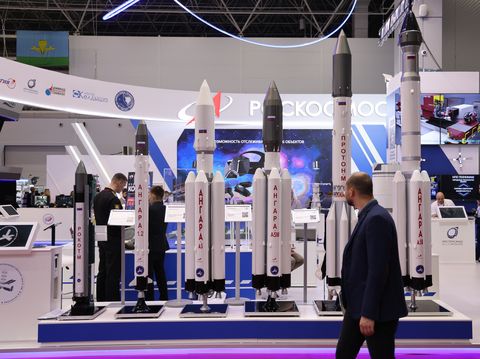



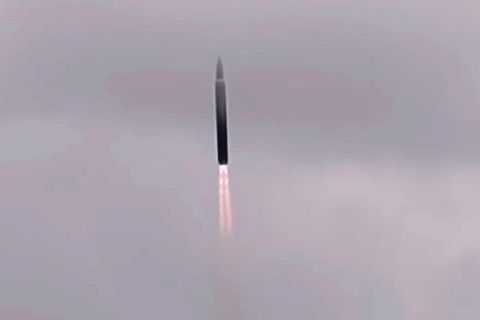
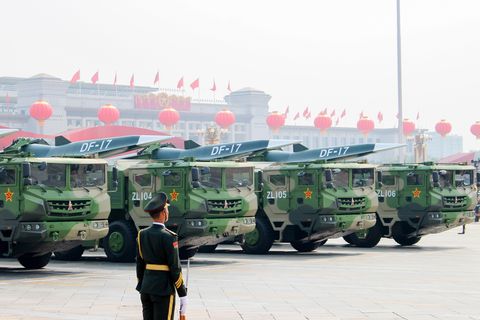
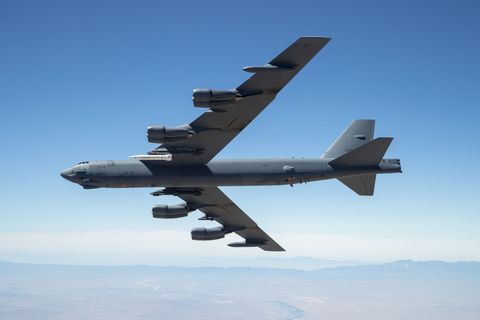
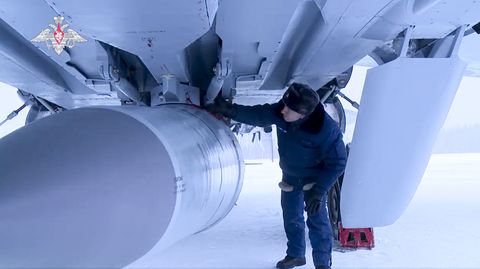



Geen opmerkingen:
Een reactie posten